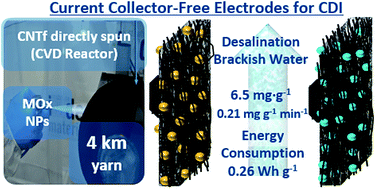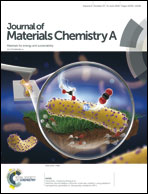Interconnected metal oxide CNT fibre hybrid networks for current collector-free asymmetric capacitive deionization†
Abstract
Capacitive deionization (CDI), a water desalination technology based on the electro-deposition of salt ions in porous electrodes, is considered a simple, non-energy intensive method to produce clean water. This work introduces a new current collector-free CDI architecture based on electrodes consisting of a porous metal oxide (MOx) network interpenetrated into porous fibres of carbon nanotubes (CNTf). The full CDI device, comprising a stack of γ-Al2O3/CNTf and SiO2/CNTf anodes and cathodes, respectively, has a large salt adsorption capacity of 6.5 mg g−1 from brackish water (2.0 gNaCl L−1) and very high efficiency of 86%, which translates into a low energy consumption per gram of salt removed (∼0.26 W h g−1). This is an 80% improvement compared with reference devices based on activated carbon electrodes and titanium foil current collectors. The remarkable efficiency obtained is due to the morphology of the electrodes, in which the CNT fibres act simultaneously as a current collector, active material and support for the metal oxide. Such architecture leads to high capacitance while minimizing internal resistance, as confirmed by cyclic voltammetry and electrochemical impedance spectroscopy. The fact that full electrodes can be made continuously, as demonstrated on 4 km of CNTf, makes the fabrication process more attractive.



 Please wait while we load your content...
Please wait while we load your content...